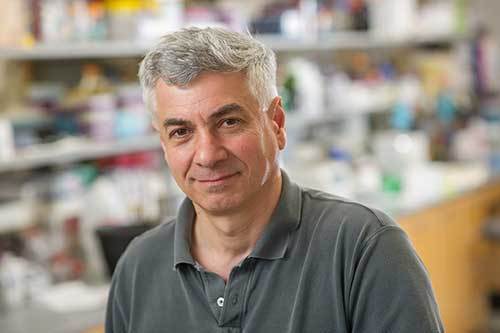Outsmarting antibiotic resistance: Mobashery lab and collaborators find a new way to fight MRSA
In work recently published in Nature Chemical Biology, a team of researchers led by Shahriar Mobashery at the

University of Notre Dame have found a possible way to treat one of the most common, and dangerous, bacterial infections in the U.S. by restoring effectiveness to antibiotics that haven’t been effective in decades.
After screening 11 million compounds virtually, the researchers worked on several candidates that inhibited a receptor, a bacterial protein called BlaR. BlaR is associated with the detection of beta-lactam antibiotics, like penicillins, in methicillin-resistant Staphylococcus aureus, (MRSA), which is a family of bacteria resistant to many antibiotics. MRSA is responsible for about 11,000 deaths each year in the United States.
“[The goal of our research] is to overcome the problem associated with MRSA,” said Mobashery, Navari Family Professor in Life Sciences in the Department of Chemistry & Biochemistry. “It’s a big killer.”
Once BlaR detects the presence of a beta-lactam antibiotic, it mobilizes the resistance mechanism against the antibiotic. While working with some of the candidate molecules that inhibited BlaR, researchers discovered an inhibitor for the receptor that shut down the function of the protein. Without functional BlaR, the MRSA bacteria became sensitive to the beta-lactam antibiotics, restoring the effectiveness of the beta-lactam antibiotics against MRSA. This worked both in vitro and in a model.
Mobashery has been studying MRSA for the past 15 years, trying to understand how MRSA escapes the effects of an entire class of antibiotics. The beta-lactams, which include common antibiotics like penicillins and cephalosporins, function to impair the cell walls of bacteria. The BlaR receptor, which is located in the bacterial cell wall, alerts the bacterium of the presence of the antibiotic. Through a set of complex processes involving several other proteins, the bacterium becomes resistant to the antibiotic.
Mobashery’s team blocked the receptor site in a different way than the antibiotic itself. By creating an inhibitory molecule that binds the receptor, the researchers block the signal before MRSA activates its antibiotic resistance pathway.
Van Nguyen, a postdoctoral researcher in Mobashery’s lab, emphasized that using an inhibitor molecule and antibiotic as a combination treatment for MRSA is a new way to think about drug development.
Inhibitor molecules like the one highlighted in this study are less likely to lose activity because they don't work in the same way as antibiotics, Nguyen said, “The concept of it has opened a new mechanism; if you want to put effort into developing a drug for Gram-positive [bacteria], this is where you should be looking.”
Inhibitors like this may vastly increase treatment options for MRSA. “To introduce a new antibiotic into the market is very difficult,” said Nguyen, but added that antibiotics that have met their obsolescence already have a wealth of information, and are usually cheaper in hospitals around the world.
Can this technique be used for other antibiotic resistant bacteria? Mobashery says that scientists first need to understand the underlying biology of each pathogen.
“Nature is very versatile in making various mechanisms of resistance, there’s literally hundreds of them. [...] Understanding the key mechanistic culprit for every pathogen is the key to understanding how to go after them.”
However, there are other infectious bacteria that share similar antibiotic resistance machinery with MRSA. These include Enterococcal infections, which are often associated with UTIs and wound infections. This may pave the way towards effective treatment of the millions of antibiotic-resistant bacterial infections in the United States each year.
Other authors include Biruk T. Birhanu, Assistant Research Professor Choon Kim, Jingdong Yang, Amr M. El-Araby, Valerie A. Schroeder, Neha Rana, Safaa Sader, Caitlyn A. Thomas, Rhona Feltzer, Research Professor Mijoon Lee, Research Professor Emeritus Jed F. Fisher, and Research Professor Mayland Chang, all researchers from the Department of Chemistry and Biochemistry at Notre Dame; and Vega Miguel-Ruano, Mayte Batuecas, Eva Jiménez-Faraco, Alejandra Alba, and Professor Juan A. Hermoso, all researchers from the Structural Biology Department at the Instituto de Química-Física “Blas Cabrera”, Consejo Superior de Investigaciones Científicas in Madrid, Spain.
The work was funded by the National Institutes of Health (NIH), the Spanish Ministry of Science and Innovation, and the Swiss National Science Foundation.
Originally published by at science.nd.edu on August 09, 2024.
Latest Research
- ‘A special challenge’: German studies scholar wins National Humanities Center fellowship for research on medieval womenFor CJ Jones, the joy of research is not the answers but the journey. And the next step on that journey is a fellowship with the National Humanities Center. …
- Notre Dame Lead Innovation Team partners with local WIC program to identify, prevent lead poisoning in childrenB.A.B.E. store “shoppers” now have something new to help their families: free lead screening kits offered by the University of Notre Dame’s Lead Innovation Team.
- Notre Dame Welcomes Ninth Cohort of Warrior-Scholars for Transformative Academic JourneyNOTRE DAME, IN – The University of Notre Dame recently concluded its ninth successful Warrior-Scholar Project (WSP) boot camp, hosting 34 dedicated Warrior-Scholars from June 21st to 28th. This intensive, week-long academic residency provided transitioning service members and veterans…
- Entrepreneurship and Empowerment in South Africa study abroad program celebrates 25 yearsThis year, the Entrepreneurship and Empowerment in South Africa (EESA) program marked its 25th year of operation. EESA is a six-week summer study abroad program that enables students to help historically…
- Vatican honors Martin and Carmel Naughton with papal awardCarmel…
- Brain tumor growth patterns may help inform patient care managementAssistant Professor Meenal Datta (University of Notre Dame/Wes Evard) A team of researchers from the University of Notre Dame, Harvard Medical School/Massachusetts General Hospital, and Boston University has developed a technique for measuring a brain tumor’s mechanical force and a new model to estimate how much brain tissue a patient has lost.













